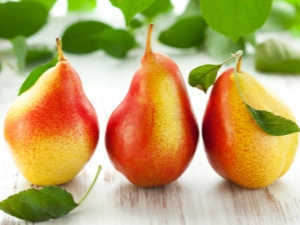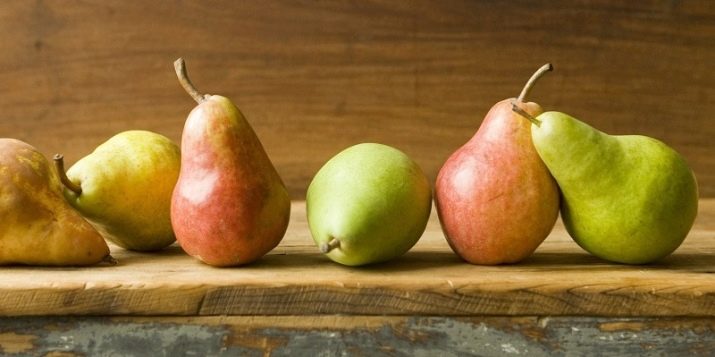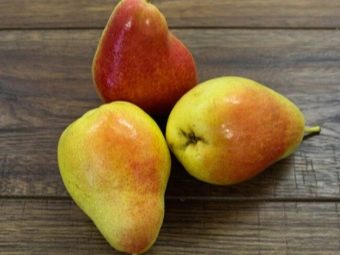Pear: composition, calorie, benefit and harm

Pears, along with apples, are affordable and versatile fruits. At the same time, many people prefer pears, unable to resist their juicy honey pulp, sweetish fruit aroma.
Composition
Pear is characterized by a wealth of chemical composition, which makes it one of the most useful fruit for the human body. It contains vitamins A, C, PP, P, K and vitamins of group B. The mineral composition is represented by such micro and macro elements as zinc, magnesium, manganese, iron, phosphorus, copper, iodine. Most of these elements are dissolved in water, which occupies more than 90% of the volume of the pear. It is right to call water structured, by its properties it is close to that which washes the internal organs of a person.
In addition, the fruit contains dietary fibers and pectins, tannins. The sweet taste of the fruit is due to sugars, the content of which depends on the characteristics of the pear variety, the place of its growth and the degree of maturity. Interestingly, sugars are more represented not by glucose, but by fructose. This is important in terms of the fact that fructose does not need to produce insulin for absorption.
Fruits also contain biologically active flavonoids, in particular, quercetin, known for its antioxidant action. Essential oils in the composition provide a pleasant aroma of fruits, strengthen immunity and improve mood.
The nutritional value
As already mentioned, the calorie content of fresh pears is 42 kcal, 1 piece of pears, this must not be forgotten, contains more calories, because the fruit weight exceeds the specified 100 g. BJU looks like 10.9 / 0.4 / 0.1 g. Caloric content usually slightly lower than the same indicators of varietal pears due to lower sugar content.
The main part of the composition - carbohydrates. Per 100 g of their fresh fruit accounts for about 10.9 g. In different varieties of fruit, their number may vary slightly. In some, it reaches 15.9 g. Of these, a third is accounted for sugars (mainly fructose) and one part for dietary fiber.
Calorie and glycemic index
Fresh pears can be considered dietary fruits. Per 100 grams of pears with peels have a little more than 40 calories (kcal). Few people weigh it before they eat food, so it’s always good to know how many calories are in one piece of medium size.
The average weight of a pear is 130-140 g, so its calorific value reaches 47-57 kcal. Larger fruits may have calorie values up to 75 kcal. The glycemic index of fruits is low - 33 units, what makes possible their consumption in diabetes mellitus type 2 and obesity.
Save fruit for future use allows turning them into dried fruits. Dried pears, if you comply with the technology of drying, their usefulness is not inferior to fresh counterparts. However, in the process of drying, they lose water, so the concentration of sugars increases, and with it the caloric content. The energy value of 100 g of dried fruit - about 250 kcal.
But if you bake fresh pears, then their caloric content remains almost unchanged and is 46-50 kcal per 100 g. At the same time, dietary fiber becomes softer, so these fruits are preferred by people with digestive problems (if rough fiber causes abdominal pain).
Baking with sugar, honey and nuts significantly increases the calorie content of the dish. In addition, some people like to bake pears with spices. The latter themselves are not able to significantly increase the energy value of the dessert, but can stimulate the appetite.
Calorie fresh pear juice is the same as in fresh fruit. True, it contains much less fiber. These indicators are valid for natural fresh. Store counterparts should be stored for a long time, so they contain, at best, preservatives and sugars, which increases their caloric content.
High calorie jam and candied pears. But It is worth noting that with proper heat treatment, they retain almost all the useful elements as fresh. The energy value of jam is on average equal to 273 kcal / 100 g, candied fruit - 343 kcal for the same volume.
Pears, like apples, can be yellow, red and green. However, unlike them, it always has approximately the same caloric value, equal to 42-45 kcal / 100 g. In other words, when the balance of sugar and organic acids changes, the nutritional value of fruits remains unchanged. For example, the more sour crushing “Conference” has the same caloric content as the sweet “Autumn”.
The only exception is an earthen pear, better known as Jerusalem artichoke. 100 g of the latter contains 73 kcal.
Another important point: the most useful pear - seasonal. And for each region the greatest value is the one that grows in these edges.
What is useful?
Pears contain many vitamins and minerals, which has a positive effect on the immune forces of the body when it is used. Regular eating pears can strengthen the immune system, which is useful for human health - it increases the body's resistance to viral and catarrhal diseases, and negative environmental factors.
The presence of iron, potassium and magnesium, PP vitamins and biologically active flavonoids makes pears for the heart and blood vessels obvious. On the heart muscle, the fruit rejects a firming effect, improves conductivity.
Other components, including vitamin PP, increase the elasticity of blood vessels, capillary permeability. As a result, blood circulation and vascular condition are improved, and the level of “bad” cholesterol is reduced. Cells and tissues of pear pearls get enough oxygen because the fruit contains iron. It helps to maintain an optimal level of hemoglobin in the blood.
B vitamins are involved in the process of blood formation, contributing to the increase in red blood cells. With their help, as well as under the influence of vitamin K in the body, it is also possible to regulate blood viscosity. Magnesium shows an anticonvulsant effect, helps prevent and relieve muscle hypertonia.
Fruit increases the stability of the nervous system to stress and depressive moods, this is largely due to the high content of B vitamins in the composition, which help to improve the transmission of nerve impulses, strengthen the nerves, help fight insomnia. Gentle pulp and fruity, slightly sweet aroma, undoubtedly, will lighten the mood. In other words, a pear can be considered an antidepressant.
For men, a high content of vitamin B, zinc, as well as the antibacterial effect of pears has a beneficial effect on the reproductive system and hormones. Under the influence of vitamin B and zinc, testosterone is produced.
Low calorie pear and a large amount of fiber allows you to consume a pear for weight loss. It contains organic acids that improve digestion and accelerate it. Fiber stimulates intestinal motility and helps remove toxins and toxins from it. This, in turn, allows you to speed up metabolic and lipid processes. But it is precisely a violation of metabolism becomes one of the main causes of a number of diseases and problems with obesity.
Dietary fiber helps to gently cope with the problem of constipation, that is, fresh fruit has a laxative effect. Broth based on leaves and fruits, on the contrary, helps to cope with diarrhea, has firming properties. Strong, slightly astringent pears are also characterized by strengthening properties; therefore, they are not recommended for people suffering from constipation. Seeds of fruits - natural antihelminthic and anti-parasitic agent.
Due to the antioxidants in the composition of the pear also remove toxins, slow down the aging process of cells, have some antitumor effect.According to its antibacterial properties, fruits can be compared with broad-spectrum antibiotics, and also show a slight antipyretic effect. Unlike a number of fruits containing organic acids, pears do not cause a sharp increase in hydrochloric acid in the stomach, and therefore can be consumed even with an ulcer and gastritis. In addition, their reception is shown in the first stages of cholecystitis as a natural product that facilitates the patient's condition. Pear contains a lot of iodine, which makes the fruit useful for the thyroid gland. It is responsible for the production of hormones, which are known to regulate all vital processes in the body.
Fruits have a diuretic effect and help to remove excess moisture from the body. If we recall the antibacterial effect of pears, then we can say that these fruits can be used as preventive products against diseases of the urinary and reproductive systems. The composition of pears contains such vitamins as B1, -2, -5, -6, -9. The latter is known as folic acid. It is vital at the stage of pregnancy, because it participates in the formation of the nervous system of the fetus, brain and spinal cord. In addition, the immunostimulating properties of a pear, its ability to improve digestion and increase hemoglobin are also very useful for a woman in a position.
Since the pear’s sweetness is due to its fructose content, it does not adversely affect the pancreas. This means that after consumption of the fetus insulin jumps are excluded. In addition, a large amount of fiber prevents the rapid absorption of sugar into the blood. This allows you to eat pears with type 2 diabetes.
True, at first it is better to get the advice of a doctor. Like apples, pears rarely cause allergies, since they contain no salicylates and benzoates.
Contraindications
Pears with firm skin and pulp contain a large amount of fiber, therefore, when the intestines are weak, they can cause abdominal pain, a feeling of heaviness. During the exacerbation of gastritis, ulcers, pancreatitis pear is prohibited.
Do not serve this fruit as a dessert immediately after the main food. It is not recommended to drink them with water. All this is fraught with the occurrence of putrefactive processes in the intestines, the appearance of a feeling of bloating, a violation of digestion. It is better to allocate for eating pears a separate meal.
Unripe pears, like overripe, damaged, with traces of rot will bring a person not a benefit, but only harm. Their composition is unknown, which means that the truth about the benefits of imported pears, which appear on the counter in the off-season, is controversial. Refuse to buy should and if the fruits have a beautiful glossy surface. It is obtained by chemical treatment of pears, and the applied composition is not completely washed off, even in hot water.
Usage features
Pears should be consumed with the peel, because it contains the main amount of ascorbic acid and fiber. The maximum dosage for an adult is no more than 2 fruits per day. Do not jam the pears, drink them with water, especially cold.
When losing weight
Those who want to lose weight, normalize metabolism and clean the intestines can regularly include pears in their diet. To do this, it is better to select a separate meal and eat pears with the skin, and, if possible, together with the bones. In the absence of contraindications, it is allowed to consume 1-2 fruits daily, choosing varieties with a small amount of sugar (they taste more solid and sour).
For more effective and rapid weight loss, you can resort to fasting days on pears. For a week on such a diet, as the reviews say, one can “throw off” up to 3-4 kg without feeling hunger and not exposing the body to an acute vitamin-mineral deficiency.
There are many diets, but the following is the most popular.The essence of this food system comes down to the fact that before lunch you can consume almost any food (as part of proper nutrition, of course). Nutritionists in this case recommend taking breakfast from slow carbohydrates (porridge) with a small amount of protein (cottage cheese, eggs).
Snacks can be “given away” to fiber and fatty acids (vegetable salad, nuts, seeds, and a handful of dried fruits) seasoned with olive oil. At lunch, you need to "lean" on carbohydrates (40% of the serving). The rest should be represented by proteins and fiber (a side dish of buckwheat, rice, spaghetti of firm varieties with boiled breast or steamed fish and a large portion of vegetable salad will fit perfectly).
After lunch, eat only raw pears. The first portion should be eaten no earlier than 2-3 hours after a meal. You can diversify a pear diet by replacing one of its methods with fresh pear juice, pear salad and low-fat yogurt, baked fruits. It is important to monitor the water balance. As a drink, in addition to the specified fresh juice, suitable mineral water, herbal teas, nonfat kefir.
As you can see, this diet is not associated with a strong reduction in daily calorie. For more impressive results, you can use a two-week diet, during which you can get rid of 7-9 extra pounds. Breakfasts here are represented by a small slice of whole-grain bread or a portion of oatmeal on the water with a pear. Lunch - buckwheat, wild rice with boiled breast. Dinner - vegetables and herbs. In between meals, 1-2 pears are eaten.
When going on a diet it is important to remember that no matter how desirable the result is, extreme weight loss in a short time is a stress for the body. And pounds dropped so fast are usually returned, “bringing” new ones with them.
Pancreatitis
The menu for pancreatitis depends on the characteristics and stage of the disease. Especially strict diets have to adhere to during exacerbation of the disease and in the first days of recovery after it. During the exacerbation of pancreatitis consumption of pears is prohibited. At 7-8 days in the period of remission, it is allowed to introduce some fruits and vegetables into the patient’s diet.
Preference is given to non-acidic apples. And although they contain more organic acids, they are better absorbed than pears. The latter contain stony cells in which chemical elements (cutin, calcium carbonate), which are not digested by the stomach of the sick person, can concentrate. Their presence can be guessed by the dense patches that are present in the pulp of pears.
In chronic pancreatitis, it is allowed to eat 1 fruit once a week. It is better to divide it into 3-4 parts and distribute it over several days. That is the best option - a quarter of fresh pear every 1-2 days. It is better, of course, to bake the fruit, because it is so possible to soften the stony cells mentioned above.
You can also cook pears compotes and decoctions. In this case, the notorious stony compounds will settle at the bottom of the dishes. They should not be drunk, and before applying it is advisable to filter out the compote or decoction.
During pregnancy
Pears during pregnancy will provide a woman's body with folic acid, strengthen the immune system and the cardiovascular system. In addition, they will cope with constipation, often arising in the first and third trimester of the “interesting situation”.
During pregnancy, it is allowed to eat 1-2 fetuses every other day. Do not eat them before breakfast and immediately after the main meal. A good option is to eat fruit at lunch or as a second breakfast. But from eating these fruits at night is better to refuse because of their diuretic action.
In the last trimester of pregnancy, the growing uterus suppresses many internal organs, including the intestines. Stimulation of the latter can provoke uterine contractions, which is fraught with preterm labor. In this regard, in the last weeks of gestation It is recommended to clean pears, reduce the frequency of their consumption to 1-2 times a week. You can replace the fruit with fresh juice.
To learn how to cook whole pears for the winter, see the next video.





































